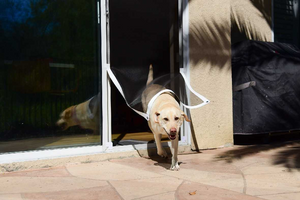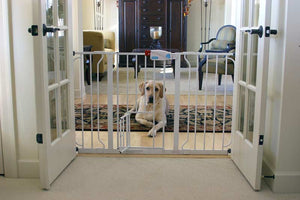Ultimate Guide to Microchips and Pets
What’s a Microchip?
You’ve heard it: My pet is chipped. So what actually is a pet microchip? What are microchip companies? How do pet microchips work? Where does an animal microchip go? What is the cost of microchipping pets? Why would my pet need one if they’ve got a handy collar tag that has an address and phone number in case they get lost? Valid questions. We get you!

So how do microchips work? A microchip id is a tiny computer chip containing an identification code that is entirely unique to your pet for their whole life. Your vet knows how to microchip a dog, and will perform the procedure in a matter of seconds. Microchip dog cost varies depending on where you go, but generally, it’s around $45. Think of pet microchip registration as a social security number!
Veterinarian offices and animal shelters are equipped with microchip scanners to help identify lost pets that are brought in by the people who find them. When scanned, the radio waves put out by the scanner activate the chip, providing the unique identification number, like their own ID tag or ID number. From here, the person who scanned your lost dog can enter the identification number into one of the few microchip registries, which holds the contact information assigned to that pet.
Most vet clinics and shelters work as "pet recovery services" because they are equipped with universal scanners that are able to read any brand of microchip. This is why microchipping is the most effective and reliable way to ensure that your found pet can be safely returned to you and home again.
How the Process Works:
So how do we go about getting a microchip? And how much does it cost to microchip a dog? How much does it cost to microchip a cat? This is simple! Implanting a microchip in a dog or cat can be done at a routine vet visit for around $50; just make sure to make an appointment at your local vet clinic!
The simple process does not take very long at all—the vet injects the microchip beneath the surface of your pet’s skin (usually between the shoulder blades) and voila! You have a chipped pet. Anesthetic treatments vary among clinics, but the actual process is similar to any other injection or vaccination, but with a bigger needle. The chip itself is comparable to the size of a grain of rice, and they won’t experience any pain once it’s in.

Once the dog's microchip is successfully implanted, pet owners can register the identification tags in the registry of the brand that your vet uses. From here you will provide the necessary contact information to ensure that if your pet does get lost, the person scanning their microchip upon being found can contact you. We recommend keeping a personal record of your pet identification number as well.
Microchip identification numbers cannot be changed, but it is extremely important that your contact information is accurate and up to date. Make sure to check and update your information on the registry regularly. If at some point you need to know your pet’s microchip number, just bring them into the vet where you had the chip implanted and ask them for the identification number on file, or simply have them scan your pet.
Info You Need to Know: Minor Details, Safety Concerns, and Everything in Between!
Benefits of Microchips: You may think that a collar tag is enough, but collars can often fall off or get caught on fencing, etc., in which case your pet would no longer be identifiable without a microchip. The microchip ensures that your pet can always be identified. The majority of shelters and vet clinics have universal scanners, which means that they can read any microchip, regardless of the brand! Check out some more microchipping advantages on our blog.
Microchipping Standards: Microchipping is not mandatory in the U.S., but almost all shelters scan for chips whenever a lost pet is brought in, increasing the chances of getting in contact with the owner. Similarly, the International Standards Organization has approved a universal identification system for microchips intended to work worldwide. These standard microchips are recommended in the U.S. because it means that if you were to relocate abroad with your pet, the ISO scanners would still be able to read your pet’s identification number if they happen to get lost.
Microchip Technology Myths: A common misconception about microchipping your pet is that it allows you to track your pet with a cellphone GPS. This technology does not exist, but microchipping is the most reliable technology available to increase the chances of getting your pet back if they get lost.
Side Effects & Safety: Some people are skeptical about microchips, as they’re worried that there may be harmful and possibly life-threatening side effects caused by it. For the vast majority of pets, the microchips are extremely safe and have no side effects. The most common issue is the migration of the chip, in which it slowly moves toward a different part of the body. If this is the case, bring your pet to the vet. Only in very rare cases have there been life-threatening effects.
Only four out of the four million pets that have been microchipped since 1996 have been documented to have developed a cancerous tumor because of the microchip, and other side effects have been minimal. For more information, check out the AVMA's literature review on Microchipping of Animals. Microchips have been carefully developed as to not disturb pets’ internal functioning. The benefits of having a microchip far outweigh the very minimal chance of side effects.
Transferring Ownership: So you’re bringing in a pet whose owner had them previously chipped. What now? The person who is giving away the pet is responsible for initiating the transfer. In order to transfer the chip identification, the previous owner will need to call the microchip registry and request a transfer. The transfer varies depending on the company with whom the microchip is registered.
Microchip Removal: Removing microchips is fairly uncommon, but some people want the microchip removed from their pet, depending on the situation. Because the chip is embedded under the skin, removal requires surgery. Veterinarians typically want to run an X-ray to be sure of its exact location prior to performing the surgery. The removal of microchips is usually not recommended.

Microchip Pet Doors
Just when you thought there was nothing else to learn about microchips. . .
Microchip pet doors have been on the rise recently. From neighborhood cats to persistent raccoons infiltrating basic pet doors, people are tired of their pets’ safety being jeopardized inside their own home. Microchip pet doors solve all these problems! Equipped with radio frequency identification technology, the microchipped pet doors are programmed to sense a pet’s personal microchip. The door only opens when the dog or cat is present in front of the door, preventing any other unprogrammed pets or critters from entering. These doors are your best bet when it comes to keeping out raccoons. You can also add a timer to an electronic pet door.
Pets’ safety will no longer be compromised, and no more sleep will be interrupted by unwelcome visitors! These are the only doors with technology advanced enough to keep out other animals. Most microchip doors store information for multiple chipped pets, so these doors are beneficial for people who have multi-pet households.
One common limitation that comes up with microchip doors is that the chip-sensing technology is less consistent with larger dogs. Because they are taller, their chips are further away from the sensor. Training them to bend down closer to the door is one way to get around this hiccup. Most doors also offer an RFID collar key, which attaches to the dog’s collar. When bending down, the dogs no longer have to be as close to the pet door in order to activate it.
We generally recommend the microchip doors for cats and small dogs, as it typically yields the best results for them. The RFID collar keys also work for pets who aren’t chipped; the microchip pet doors are suitable for owners who have both chipped and unchipped pets. Find more information on RFID and microchip differences to determine if your pet can use these doors. Check out the 2019 best electronic pet doors to get an overview of the top-rated microchip doors, or visit our electronic dog and cat door page for an array of microchip-activated, automatic, and smart pet doors.





Hi Jessica,
The High Tech Power Pet Patio Pet Door would be a great option for you: https://www.petdoors.com/products/high-tech-slider.
It is an automatic door that only opens for a collar key that your dog would wear. If you have any questions, please feel free to call us at 1-800-826-2871 or email customerservice@petdoors.com.
Happy New Year!
Hello, I currently have a 7month old large breed puppy and 3 indoor cats. I have an attachment for the dog door so he can go out when needed but now the cats have figured that out. Looking for a type of slider door attachment where he can wear something on his collar and it is automatic and will only open for him. Do you guys offer that?